#Large group of fungi
Explore tagged Tumblr posts
Note
Wait, which animals raise livestock?
Several species of ants will 'herd' aphids around (a type of plant lice)- even picking them up and putting them back with the group if they wander off. The ants will attack anything that approaches their aphid herds, defending them. The aphids produce a sugary excretion called honeydew, which the ants harvest and eat.
Some ants will even 'milk' the aphids, stroking the aphids with their antennae, to stimulate them to release honeydew. Some aphids have become 'domesticated' by the ants, and depend entirely on their caretaker ants to milk them.
When the host plant is depleted of resources and dies, the ants will pick up their herd of aphids and carry them to a new plant to feed on - a new 'pasture' if you will.
Some ants continue to care for aphids overwinter, when otherwise they'd die. The ants carry aphid eggs into their own nests, and will even go out of their way to destroy the eggs of aphid-predators, like ladybugs.
--
Microhylids – or narrow-mouthed frogs - have an interesting symbiosis with Tarantulas.
While the spiders could very easily kill and eat the much-tinier frogs, and DO normally prey on small frogs, young spiders instead will use their mouthparts to pick up the microhylid frogs, bring them back to their burrow, and release them unharmed.
The frog benefits from hanging out in/around the burrow of the tarantula, because the tarantula can scare away or eat predators that normally prey on tiny frogs, like snakes, geckos, and mantids. The tarantula gets a babysitter.
Microhylid frogs specialize in eating ants, and ants are one of the major predators of spider eggs. By eating ants, the frogs protect the spider's eggs. The frogs can also lay their eggs in the burrow, and won't be eaten by the spider.
So it's less 'livestock' and more like a housepet - a dog or a cat. You stop coyotes/eagles from hurting your little dog/cat, and in return the dog/cat keeps rats away from your baby.
--
Damselfish grow algae on rocks and corals. They defend these gardens ferociously, and will attack anything that comes too close - even humans. They spend much of their time weeding the gardens, removing unwanted algaes that might overtake their crop.
The species of algae that they cultivate is weak and and sensitive to growing conditions, and can easily be overgrazed by other herbivores. That particular algae tends to grow poorly in areas where damselfish aren't around to protect and farm it.
Damselfish will ALSO actively protect Mysidium integrum (little shrimp-like crustacians) in their reef farms, despite eating other similarly sized invertebrates. The mysids are filter feeders, who feed on zooplankton and free-floating algae, and their waste fertilizes the algae farms. Many types of zooplankton can feed on the algae crop, and the mysids prevent that.
While Mysids can be found around the world, the only place you'll find swarms of Musidium integrum is on the algae farms that Damselfish cultivate.
Damselfish treat the little mysids like some homesteaders treat ducks. Ducks eat snails and other insect pests on our crops, and their poop fertilizes the land. The ducks can be eaten, but aren't often, since they're more useful for their services than their meat.
--
There are SEVERAL species of insect and animal which actively farm. They perform fungiculture and horticulture: deliberately growing and harvesting fungus and plants at a large-scale to feed their population.
Leaf-cutter ants and Termites both chew up plant material and then seed it with a specific type of fungus. The fungus grows, and the termites/ants harvest the mushroom as a food source.
Ambrosia beetles burrow into decaying trees, hollow out little farming rooms, and introduce a specific fungii (the ambrosia fungi), which both adults and larval beetles feed on.
Marsh Periwinkles (a type of snail) cultivates fungus on cordgrass. They wound the plant with their scraping tongue, then defecate into the wound so their preferred fungus will infect it and grow there. They let the fungus grow in the wound a bit, and come back later to eat.
9K notes
·
View notes
Text
Plastic is the most prevalent marine pollutant, and plastic surfaces are the fastest growing habitat in the ocean. Researchers at the University of Hawai'i (UH) at Mānoa have recently discovered that many species of fungi isolated from Hawai'i's nearshore environment have the ability to degrade plastic, and some can be conditioned to do it faster. The work is published in the journal Mycologia. "Plastic in the environment today is extremely long-lived, and is nearly impossible to degrade using existing technologies," said Ronja Steinbach, who led this research as a marine biology undergraduate student in the UH Mānoa College of Natural Sciences. "Our research highlights marine fungi as a promising and largely untapped group to investigate for new ways to recycle and remove plastic from nature. Very few people study fungi in the ocean, and we estimated that fewer than one percent of marine fungi are currently described."
Continue Reading.
490 notes
·
View notes
Text
Book recs: the evil fungi did it
We all know of The Last of Us, but that franchise isn't the only example of fungal invasions. We've got zombies and apocalypses, we've got gothic horror, we've got fantasy, we've got romance, we've got space - no genre is safe from having their characters become the home of fungal organisms.

For more details on the books, continue under the readmore. Titles marked with * are my personal favorites. And as always, feel free to share your own recs in the notes!
If you want more book recs, check out my masterpost of rec lists!


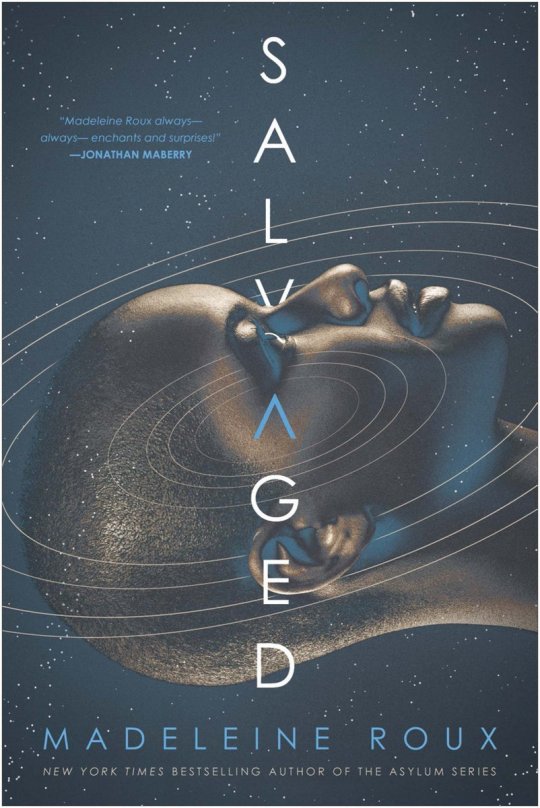
The Girl with all the Gifts (The Girl with All the Gifts series) by M.R. Carey
Want another fungal zombie apocalypse? Then I come bearing great news! The Girl with All the Gifts is a post apocalyptic novel following a group of characters fleeing across an infested wasteland, trying to stay alive and hoping to find a cure. One of the characters is Melanie, a young girl who carries the contagion inside of her and hungers for flesh, but like many children of the apocalypse has kept her humanity. Is she and children like her the answer to the cure we are looking for? Or are they the start of something entirely new? This book has also been adapted as a movie!
Cold Storage by David Koepp*
Years ago, a quickly growing fungal organism capable of wiping out humanity came dangerously close to spreading. It was contained and kept in cold storage underneath a military repository. Since then, a larger storage facility has been built on top, the dangers on the lower floor being largely forgotten. That is, until it makes a new attempt at escape. Now, two unsuspecting security guards might be all that stands in the way of complete extermination. This book is both funny and genuine in its characters, and genuinely creepy in its portrayal of body horror.
Salvaged by Madeline Roux
Rosalyn Devar is on the run from her famous family, and has run so far she ended up in space. Now she works as a "space janitor", being sent off to clean up the remains of failed research expeditions. But in trying to cope with her problems, she has fucked up on her job multiple times, and is now close to losing her position. Her last chance is the Brigantine: a research vessel gone silent, all crew presumed dead. But when she arrives to salvage it, Rosalyn discovers the crew isn't as dead as presumed. But are they still human - and will Rosalyn be able to keep her own humanity?
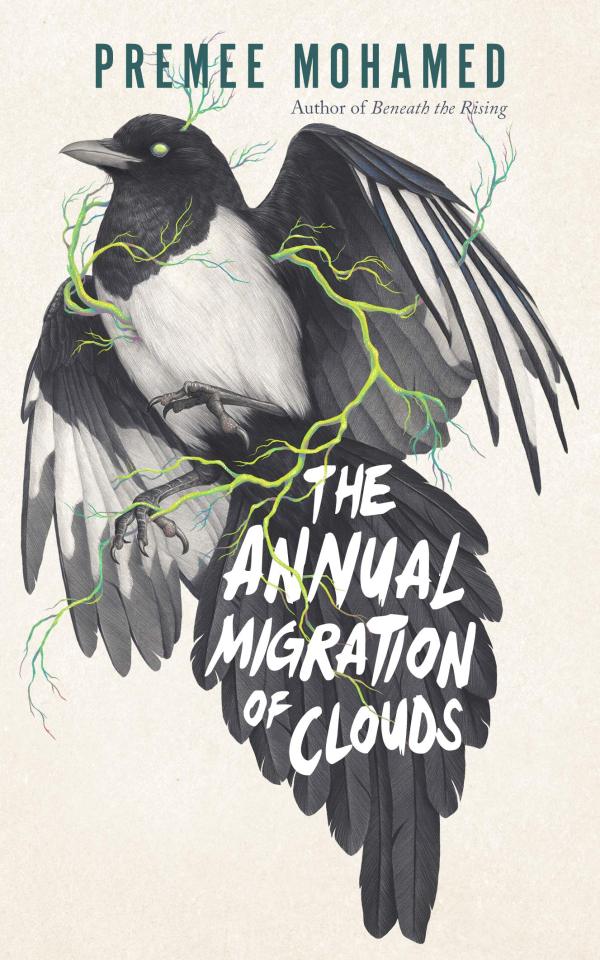

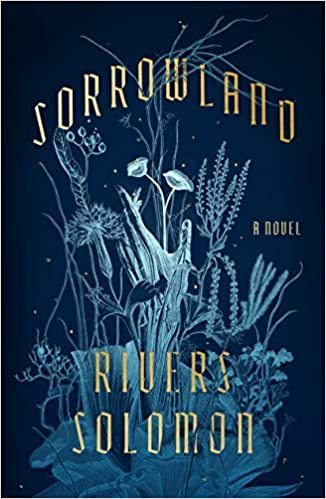
The Annual Migration of Clouds by Premee Mohamed
Novella. Reid is a young woman living in a small community after a climate collapse. Resources are scarce, but Reid's biggest problem is Cad, a mind-altering fungal parasite that lives inside her body. When she is offered a rare chance at attending a far-away university in a secluded dome community, Reid must decide whether to leave or stay to help support her community.
Mexican Gothic by Silvia Moreno-Garcia*
Noemí Taboada is a glamorous and well-off young woman, but when she receives a frantic letter from her newly-wed cousin, Noemí must leave her glamorous life and travel to find out what is wrong. As she arrives at High Place, a mansion on the Mexican countryside, Noemí is met with mysteries and her cousin's new English family. As she tries to find out the truth behind High Place and its inhabitants, Noemí's only ally is the youngest son of the family. But will she be able to find out what so scared her cousin before it's too late for all of them?
Sorrowland by Rivers Solomon
A young pregnant woman flees a cult that left her body strange and changing in terrifying ways. Hiding from both a world wanting to oppress her and the cult seeking to force her back, she does her best to raise her children while trying to find out the truth of the cult and being pursued by a hunter in a dangerous game of cat and mouse. Bleak and scary, Sorrowland is a book that will creep under your skin with horrors both fantastical and very, very real.
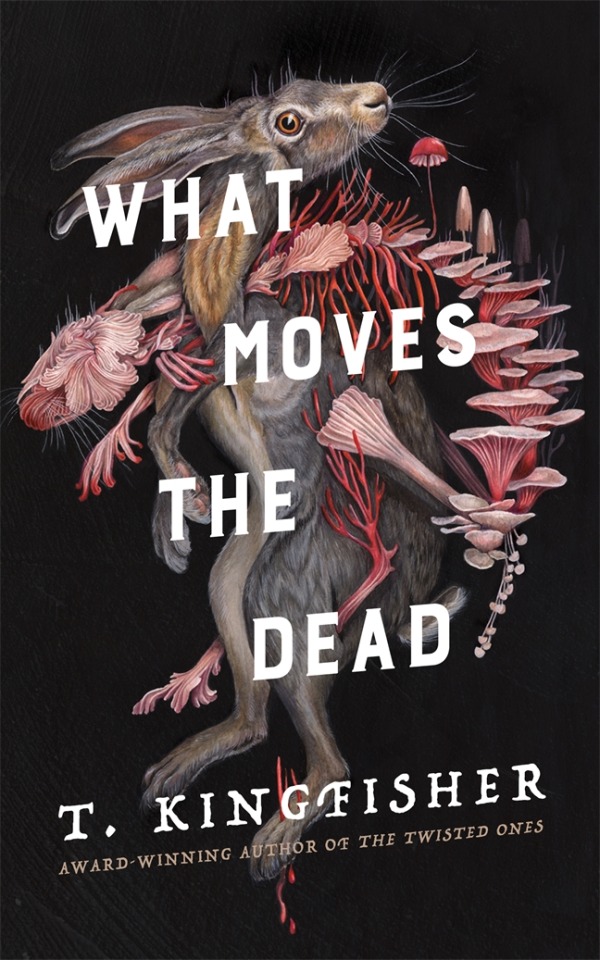

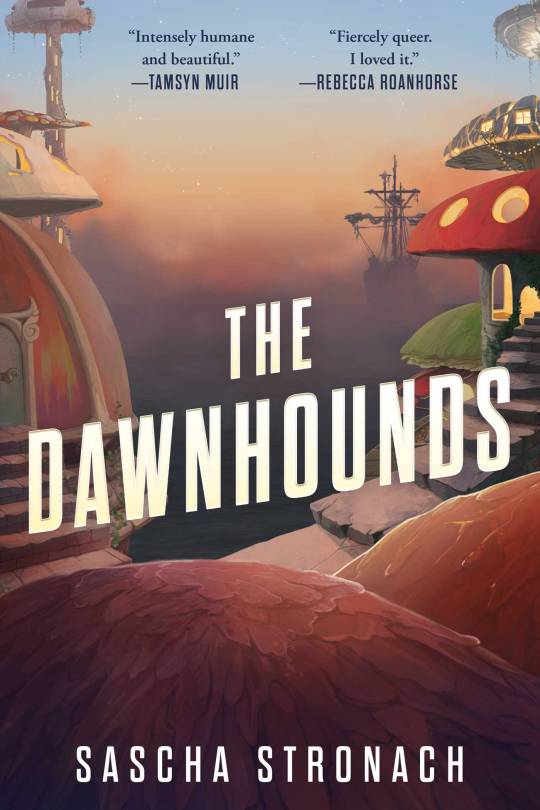
What Moves the Dead (Sworn Soldier duology) by T. Kingfisher
Novella. Alex Easton, retired soldier, travels to visit their childhood friends, siblings Madeline and Roderick Usher, after finding out that Madeline is dying. In the siblings' rural, ancestral home, Madeline walks in her sleep and looks to be fading away, while around it wildlife seems to be possessed by a strange force. With the help of a mycologist and an American doctor, Alex attempts to save Madeline and reveal the truth of her illness.
Wanderers (Wanderers duology) by Chuck Wendig
A strange illness has struck the United States: with no warning, random people with seemingly no connection simply get up and start walking. They do not eat, do not sleep, do not communicate, and they do not stop - and if you try to force them, they literally explode from the inside. Teenaged Shana isn't one of these sleepwalkers, but her little sister is. Unwilling to leave her sister on her own, Shana accompanies the growing flock of walkers, protecting them as one of many "shepherds". And this protection proves necessary, as the sleepwalkers is only the first step toward what might very well be the extinction of the human race. An 800 page epic, Wanderers is a slowburn apocalypse story with a multitude pov characters and plot threads, from fungal pandemics and all-knowing AI to the all too real portrayal of radicalization and bigotry.
The Dawnhounds (The Endsong series) by Sascha Stronach
The Dawnhounds is a book where you just kind of have to let the story and the world wash over you. It skirts the line of scifi and fantasy, with a futuristic world of environmentally friendly mushroom houses and deadly fungi bio weapons next to literally god-given superpowers and near-immortality. It’s really cool and unlike anything else I’ve ever read, but also a bit confusing. Bonus: it’s also sapphic!
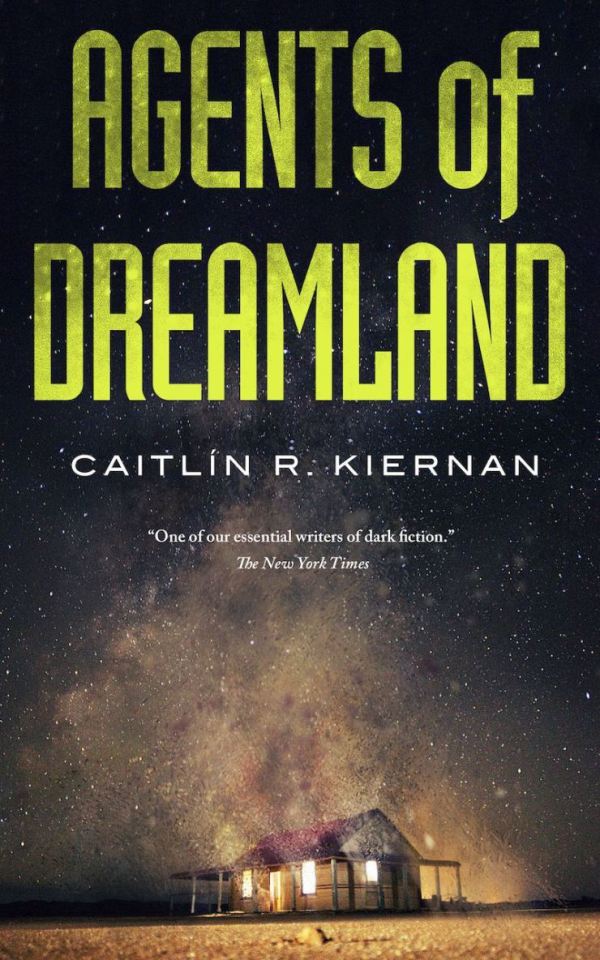
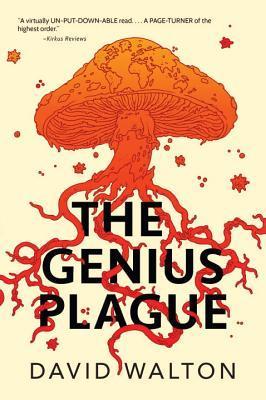

Agents of Dreamland (Tinfoil Dossier trilogy) by Caitlín R. Kiernan
Novella. A government agent known only as the Signalman; a cult preying on the young and vulnerable, promising to usher in a new age; a woman who exists outside of time, searching for a way to save humanity. Agents of Dreamland is short, but includes many spooky elements, among them an alien and possibly world-ending fungi. The narrative is non-linear and a bit strange, but also fascinating.
The Genius Plague by David Walton
Soon after landing his dream job at the NSA, things get weird for Neil Johns. His brother Paul, a mycologist, returns from a trip to the Amazon, carrying a nearly lethal fungal infection and a strangely sharpened mind. At work, Neil starts picking up mysterious messages originating out of South America, where cases similar to that of Paul starts occurring. And strangest of all: all the infected seem to be working towards the same goal. Recommended with the caveat that, while the fungal stuff is really cool, The Genius Plague is also happy to idolize American intelligent agencies and demonize environmentalism and anti-imperialism.
Little Mushroom: Judgement Day (Little Mushroom duology) by Shisi
An Zhe isn’t human. He’s a mushroom who absorbed the DNA of a dying man, allowing him to take on human guise and leave the wilderness. Entering one of the last human bases, a place struggling to keep out the mutated and dangerous creatures of the wilds, An Zhe must keep his identity secret as he searches for something which was taken from him. While not my cup of tea (frankly, I need more female characters), Little Mushroom is an undeniably unique m/m romance novel.
Bonus AKA these don't technically involve any fungi but have similar vibes of parasites and nature corrupting the human
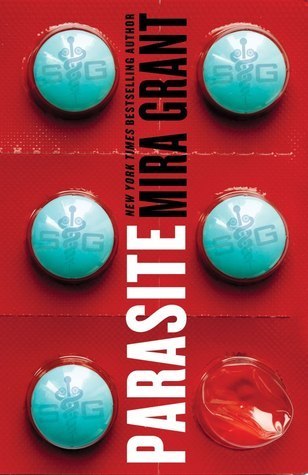
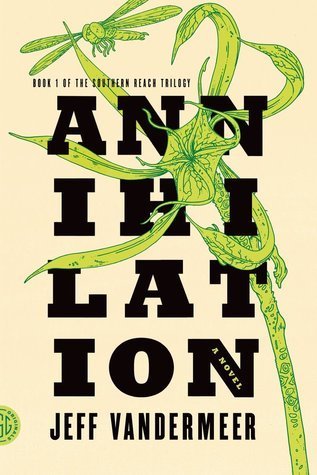
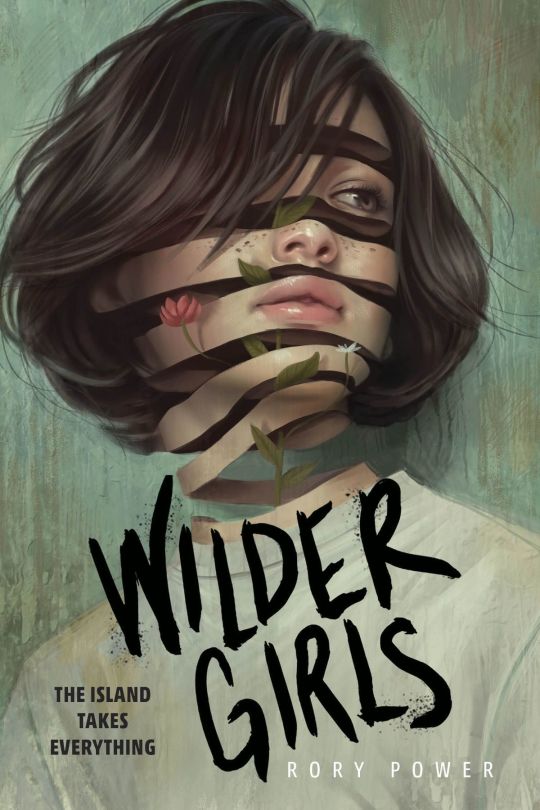
Parasite (Parasitology trilogy) by Mira Grant*
In the near future, a great leap in medical science has improved human health by leaps and bounds: a genetically engineered tape worm. Within a few years, almost every human has their own personal parasite implanted. But now, something is happening to the parasites - they want more, whether their hosts want to share or not.
Annihilation (Southern Reach trilogy) by Jeff Vandermeer
For decades, Area X has been completely cut off from humanity. The only ones to enter are small organized expeditions, many of which never return, or return... wrong. We follow the latest expedition, its participants known only as the anthropologist, the psychologist, the surveyor, and our narrator, the biologist. As they enter into Area X to try to find out its secrets, only one thing is for sure: they will never be the same again.
Wilder Girls by Rory Power
Young adult. Over a year ago, the Raxter School for Girls was hit by the Tox, a strange disease that killed off many and left the survivors' bodies slowly changing in terrifying ways. The island the school is on has been in quarantine since then, and the girls dare not leave the school grounds lest they become victims of wild animals changed by the Tox. But as they wait for the promised cure, one of the girls goes missing, and her friends are willing to do anything to find her. Unsettling, spooky, and sapphic, this is a unique read featuring body horror and messy, dangerous girls.
(Second) Bonus AKA I haven't read these yet but they seem really cool
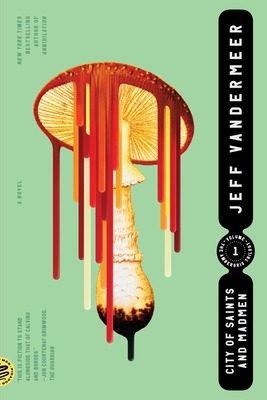
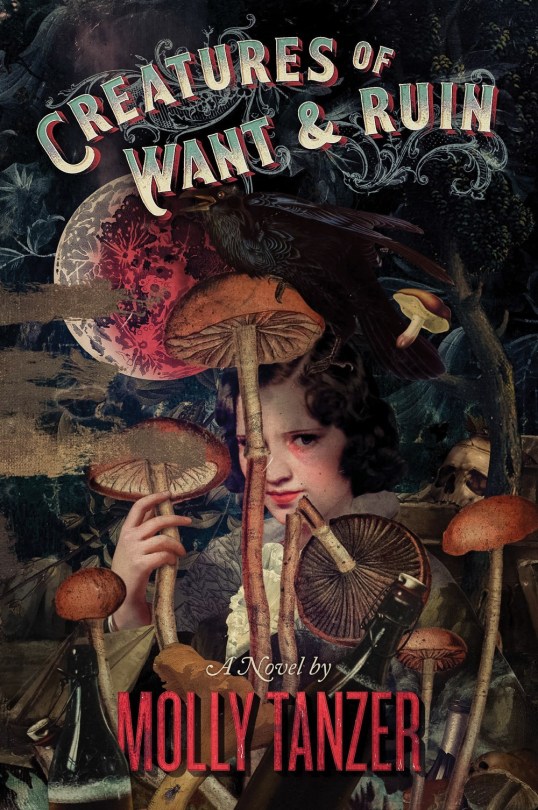
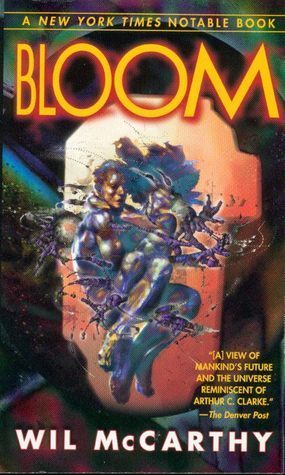
City of Saints and Madmen (Ambergris trilogy) by Jeff Vandermeer
Ambergris, a city created by a mushroom-like people, is now the home of humans, but the original inhabitants are still there, residing beneath the city.
Creatures of Want and Ruin (Diabolist's Library series) by Molly Tanzer
It’s the prohibition era, and while Ellie does fishing during the day, at night she bootlegs moonshine in Long Island. But unbeknownst to Ellie, some of the booze she smuggles has a strange source: distilled from mushrooms by a cult, it causes those who drink it to see terrible things, such as the the destruction of Long Island.
Bloom by Wil McCarthy
The inner solar system has been overtaken by fast-reproducing, fast-mutating technogenic life. Humanity has fled to the outer solar system, hiding beneath the ice of Jupiter's moon, but even here they aren't safe from possible incursion of mycospores, which lead to deadly blooms. Now a group of astronauts venture back to an infected Earth.
#the girl with all the gifts#cold storage#salvaged#the annual migration of clouds#mexican gothic#sorrowland#what moves the dead#wanderers#the dawnhounds#agents of dreamland#the genius plague#little mushroom#parasitology#annihilation#wilder girls#nella talks books
1K notes
·
View notes
Note
With tube plants, I’m really curious if any are edible, and if so what’re they like, and how avian culture sees them. While Taxonomically they’re animals, does avian culture consider them plants? For a random example, let’s say the avians, like us, had a religious period where they can’t eat meat. Would worm plants be considered off limits, or the same as anything else? Not saying that religion or whatever exists, it’s just the first frame of reference I could think of. Another example might be how fungi are considered vegetables, but are an entirely different kingdom.
As for eating, I’m curious if they have a more meat-like texture and taste, or a more plant-like one. I’m assuming the former. If they’re eaten, what are the parts that are eaten and how are they usually prepared? Do the avians have any traditions or culture regarding the tube, like we do with wishbone breaking or bone carving? Is it possible to farm them, and are they?
Avian cultures usually classify plantworms in the same group of food as shellfish, which they resemble the most nutritionally. They are more like a clam than a plant. Many are toxic as a defense against being eaten, but the ones avians can consume are usually cooked whole (in or out of shell) unless a specific body part is unpalatable (usually the gut or frond tentacles). For larger worms, they may be trimmed down to the tastiest part, the retractor muscle. It's very possible to farm them, and many are also cultivated for their beauty as landscaping plants. Their tubes are most commonly used to make plaster for building, or beads.
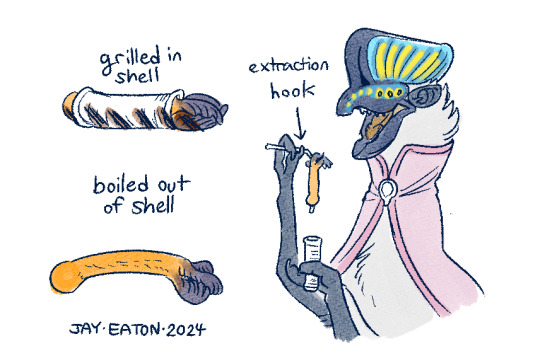
Vegetarianism is overall more rare in avian cultures than ours because they have a higher calorie-per-pound requirement than humans and many live on small islands where grain agriculture is more difficult to live off exclusively than fishing. There are several grades of culturally distinct pescetarian diets in modern avian cultures though, some of which view eating large "vertebrates" as unacceptable, land animals as unacceptable, vertebrates in general as unacceptable, only plantworms are acceptable, or hardline only plant matter and eggs (which may or may not include plant worm "leaves and flowers"... which can grow back). Hardline vegetarianism or veganism is more common among flightless avian cultures, who historically have had the most arable land.
751 notes
·
View notes
Text
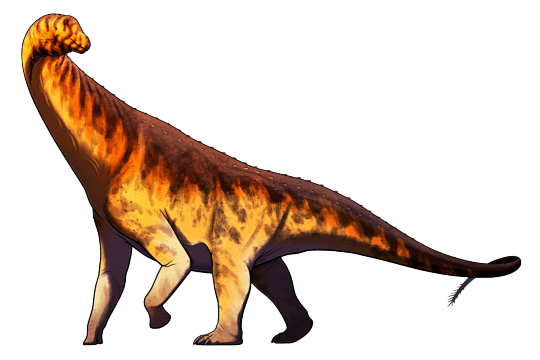
Isisaurus colberti was a sauropod dinosaur that lived in what is now India and Pakistan at the end of the Cretaceous Period, about 70-66 million years ago.
It was part of the titanosaur group of sauropods and had some unusual proportions* compared to its close relatives, with elongated forelimbs and a relatively short chunky neck. Since it's only known from a partial skeleton its full size is unknown – estimates have been made as large as 18m long (~60') but it was probably somewhat smaller, closer to around 11m in length (36').
(*Measurement errors in the original paper resulted in some very weird proportions, but more recent and rigorous reconstructions have made Isisaurus not quite so cursed-looking.)
Like most other titanosaurs it probably lacked the thumb claws seen in other sauropods, and it may also have had some bony osteoderm armor studding its skin.
Coprolites that may represent Isisaurus' poop show evidence of several different fungi that grow on tree leaves in humid tropical and subtropical climates, suggesting that this sauropod was a selective browser somewhat like modern giraffes.
———
NixIllustration.com | Tumblr | Patreon
References:
Jain, Sohan L., and Saswati Bandyopadhyay. "New titanosaurid (Dinosauria: sauropoda) from the Late Cretaceous of central India." Journal of Vertebrate Paleontology 17.1 (1997): 114-136. https://doi.org/10.1080/02724634.1997.10010958
Naish, Darren. "The hands of sauropods: horseshoes, spiky columns, stumps and banana shapes." Tetrapod Zoology, 29 Oct. 2008, https://web.archive.org/web/20121022121526/http://scienceblogs.com/tetrapodzoology/2008/10/29/the-hands-of-sauropods/
Sharma, Neeta, et al. "Fungi in dinosaurian (Isisaurus) coprolites from the Lameta Formation (Maastrichtian) and its reflection on food habit and environment." Micropaleontology 51.1 (2005): 73-82. https://doi.org/10.2113/51.1.73
Wedel, Matt. "How shortweird was Isisaurus?" Sauropod Vertebra Picture of the Week, Aug. 13 2009, https://svpow.com/2009/08/13/how-shortweird-was-isisaurus/
Wikipedia contributors. “Isisaurus” Wikipedia, 27 Dec. 2024, https://en.wikipedia.org/wiki/Isisaurus
Wilson, Jeffrey A., and Paul Upchurch. "A revision of Titanosaurus Lydekker (Dinosauria‐Sauropoda), the first dinosaur genus with a ‘Gondwanan’ distribution." Journal of Systematic Palaeontology 1.3 (2003): 125-160. https://doi.org/10.1017/S1477201903001044
#science illustration#paleontology#paleoart#palaeoblr#isisaurus#titanosaur#sauropod#sauropodomorpha#saurischian#dinosaur#art
311 notes
·
View notes
Text
Genuinely highly encourage people to find and read a book about an animal or plant or fungi or whatnot that you never really think about. Like the world is so big and so many people have written books aimed at the public on their favorite organisms that never get talked about or made into the focus of nature documentaries. Literally so many things are fascinating. Did you know that the Antarctic Krill genome is 12x as large as the human genome, and that krill gather in big enough groups that they can be seen from space?
#The Curious Life of Krill by Stephen Nicol has like 60 ratings on goodreads and more people should read about krill actually#books
143 notes
·
View notes
Text
ITS CROW TIME ITS CROW TIME!!!
Often found residing in Mushroom Fields biomes, it’s the Mushroom Crows!!!! 🍄❤️
Hope you guys love them as much as I do!
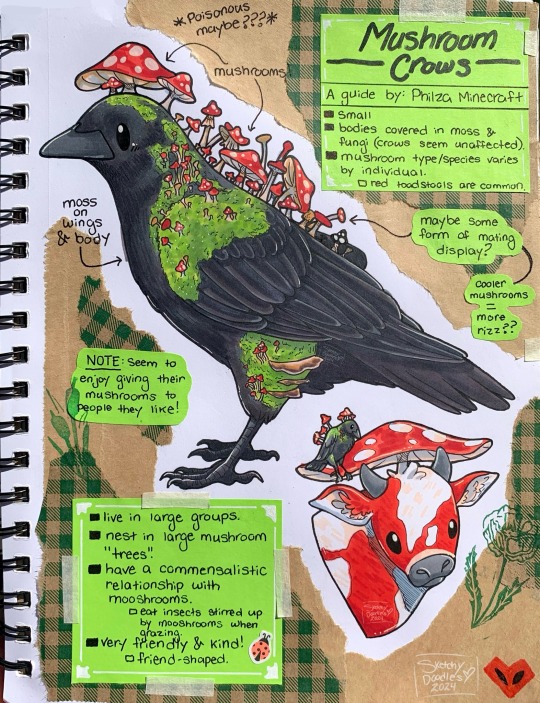
Also while it didn’t make it into the page, a friend brought up an awesome idea! (And I’ve decided it’s canon now)
Since these little dudes give mushrooms to people they like, they also have a habit of shaking their feathers and dispersing harmful spores over the people they don’t like.
Transcript and Closeups below!!! ❤️
MUSHROOM CROWS
A Guide by Philza Minecraft
Physical Adaptations
Small
Bodies covered in moss and fungi (crows seem unaffected)
Mushroom type/species varies by individual
Red toadstools are common
Behavioral Adaptations:
Live in large groups
Nest in large mushroom “trees”
Have a commensalistic relationship with mooshrooms.
Eat insects stirred up by mooshrooms when grazing.
Very friendly & kind!
Friend-shaped!
Other Notes:
NOTE: Seem to enjoy giving their mushrooms to people they like!
Moss on wings and body
Mushrooms! *poisonous maybe???*
Maybe some form of mating display?
Cooler mushrooms = more rizz???
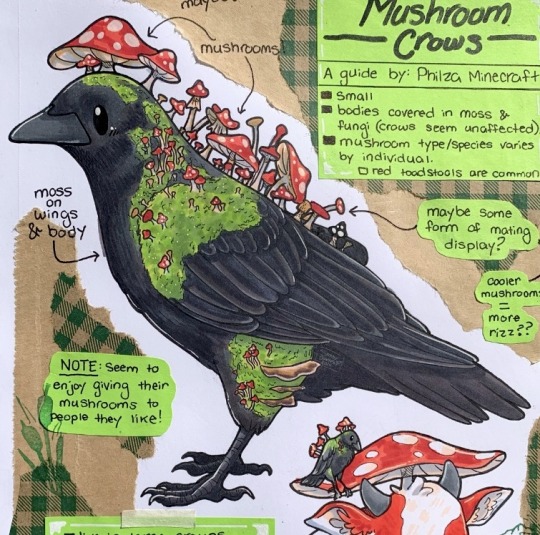
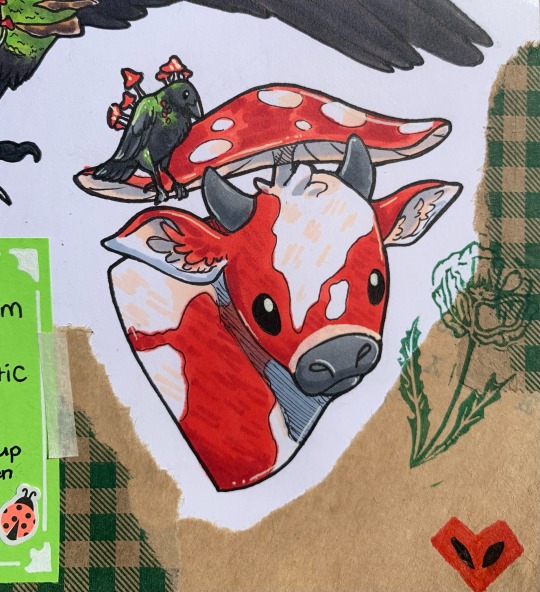

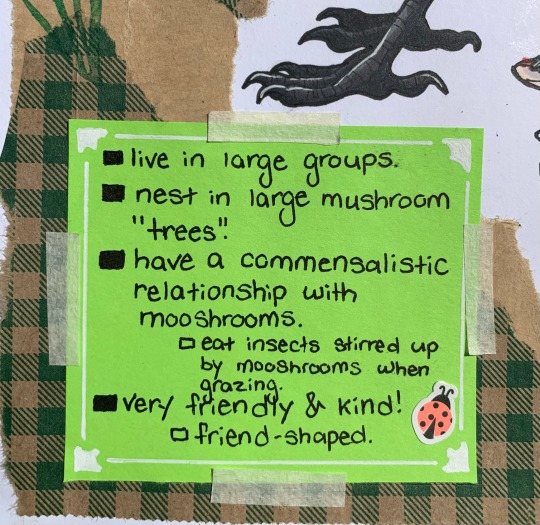
#philza#mcyt#philza minecraft#philza fanart#Minecraft#minecraft crows#sketchy’s doodles#I’m super happy with this page layout ngl#its so colorful and soft#I’m in love
767 notes
·
View notes
Text
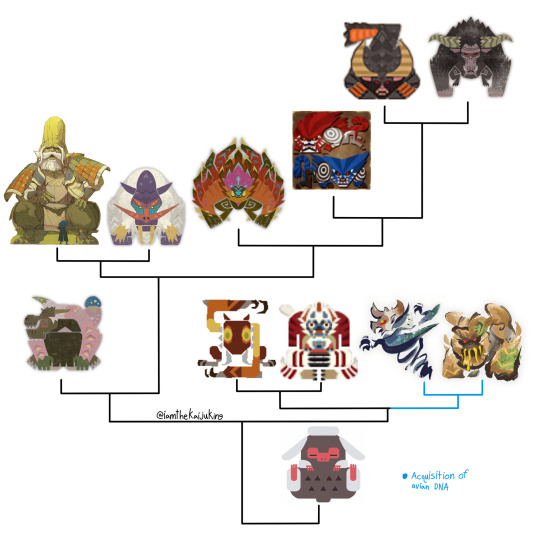
My phylogeny of the cursorial monkeys as of the release of Wilds
Gold & Pearlspring Macaque: Two species of monkey native to the hoarfrost reach.
Both species are small primates that usually take shelter in the underbrush and in caves scrounging around for small animals, and have thick fur to combat the cold. But sometimes this isn’t enough so they risk basking in hot springs to stay warm. The Pearlspring species is numerous and social, forming large family troops. The golden species is much rarer but seems to be welcomed as the Pearlspring make no efforts to drive them off.
Both species have long feet and when resting have a plantigrade leg position, but when moving they switch to digitigrade, which is a hallmark of this entire family.
Despite their appearance resembling lemurs or loris, they and by extension all members of this group are old world monkeys with close relation to the tribe Papionini (mandrills, macaques, baboons, geladas, etc). But the group itself is likely older than them.
True cursorial monkeys
Congalala: An infamously stinky species with vibrant fur.
These monkeys are somewhat social and forage together, but don’t form especially strong bonds with each other. Congas are primarily fungivores that also eat plant matter but especially fruits. They spend a lot of time digesting their hardy meals with their large and extensive digestive system which is capable of slight hind gut fermentation. Their tails are prehensile and have a padded tip for picking up food. Their mouths are especially gummy, and in fact all but the canines and incisors on their mandibles are blocked from view by their extensive gums. This gives them a slight hippo look.
For self defense Congas have large claws derived from grooming claws that can give a nasty slash and their faces and rear can flush red with blood as a warning when angry, but this pales in comparison to their other defense. The colon of the Conga is formally referred to as the Fart Chamber, and is rather large and capable of retaining waste and gas. In self defense a Conga will release the contents of its fart chamber and the foul smell and fecal matter is enough to drive away almost any attacker. There is traces of sulfur that give it a particularly strong smell and make it hard to wash out.
The iconic pink fur of Congas seems a bit odd, but is actually a vital method of anti parasitic defense. Many tropical species such as birds use bright colors in their integument as a deterrent against external parasites.
The males known as Congalala are much larger than the females and more solitary, but a Congalala usually isn’t far from a troop of Congas he’s claimed as a harem. Males have long fur on their heads that they gel into a long curved cone using the juices from the fruit they eat. This is something done to show fitness to other females, and males with bigger and more impressive cone heads are considered more attractive.
As a consequence of their more solitary lifestyle, Congalalas step up their chemical defenses. Aside from their fart chamber, they also have a small pocket in their esophagus next to the entrance of their stomach called the Burp Chamber. When eating various toxic fungi they can actually store some of the debilitating chemicals along with gas within the burp chamber to then be regurgitated at attackers.
Some particularly experienced Congalala have found ways to dye their hair as well as gel it, and these individuals have died their entire bodies a number of different colors in order to further impress females. Green is the most common but some orange individuals have been spotted.
Blangonga: An arctic species of monkey with a much more carnivorous diet.
Blango are well adapted to their environment with thick white coats that cover their bodies, except for their extremities and bald heads. They form troops to hunt as a pack to capture prey which they dispatch via their massive canines. Much like Mandrills they have distinct blue faces with snout ridges. In defense they can spew water which freezes in their cold habitats.
While most of their caloric intake is meat, Blango must occasionally consume plant matter. As monkeys they are incapable of producing vitamin C, and must gain it through food. Vitamin C is common in fruits and vegetables, but these are not common where they live, so any plants they see they will eat without hesitation to avoid scurvy. Troops may seasonally migrate during warmer periods to gorge on fruits.
Males are referred to as Blangonga and aside from size they have noticeable cranial differences from females. Their upper canines form incredibly long sabers, and they have two long bone spikes on their skulls above the canines as well as a distinct mustache growing from the cheeks. Just behind their head is also a lump of fat. These tusks, mustaches, and head boobs make them very desirable to females, and a single Male may command an entire troop of Blango. This does not mean that Blango are loyal though, as they will abandon a Blangonga that receives facial wounds that cut their mustache and breaks their tusks. These abandoned Blangonga do not survive long.
A desert subspecies exists called Copper Blangonga, which has a brown and tan coloration. They do not regurgitate water in defense as it does not freeze in their hot habitat. They’re also solitary and possibly do not possess sexual dimorphism. It’s possible that after the end of the last ice age a population of Blango became stranded in the old desert.
The dental formula of Blangonga perfectly matches with old world monkeys, with the only weird thing being that the first premolars are sharp like sideways triangular incisors. Likely an adaptation for their higher intake of meat.
Wyverians: A sapient species with long lifespans that closely resemble Homo sapiens.
It may be controversial to place them here as Wyverians hold a firm belief that they are descended from wyverns (although what kind is never specified), but a number of anatomical features say otherwise. A belly button and breasts present in many individuals firmly places them as placental mammals, and their anatomy is firmly simian. They nearly perfectly resemble humans except for their four fingered hands and feet, and the fact that they can have digitigrade legs and grow bigger than humans.
It’s these limbs that are the biggest tell as they match perfectly with the cursorial monkeys. But why lose their tails and evolve to be upright? Perhaps it could be to better free up their arms for tool use, and as they oriented their bodies vertically the tail offset their balance and was lost. Much like humans, this upright posture meant the head was held up by simply sitting on the neck vertebrae and not be held up by neck muscles that attached to the cranium. Thus allowing their brains to expand.
Many individuals can grow to astonishing size and males can become especially enormous and grow a distinctive domed head possibly composed of firm fat. The biggest known Wyverian is His Immenseness, who perfectly exemplifies these traits. These traits could perhaps be an evolutionary holdover from their sexually dimorphic ancestors who had keystone individuals in their troops.
Wyverians also live unnaturally long lifespans, rivaled only by the Actinistian elder dragons. It’s unknown why they possess such ludicrously long lives, or why it would even be necessary evolutionarily. But allow me to present a theory.
We know that many ancient civilizations have fallen in the world of monster hunter, and some especially advanced ones had access to genetic engineering. Wyverians typically inhabit the upper echelons of society or more academic spaces, with exceptions such as blacksmiths. It’s rather likely that this is a holdover from the ages long lost, and it’s not impossible that Wyverians may have gifted themselves long lives as members of the ruling class. Food for thought.
Ajarakan: A volcanic species that decorate themselves in ore that they heat up.
Ajarakan, Rajang, and their closest relatives form a family of long snouted cursorial monkeys that ancestrally dwelled in volcanic environments. This ancestor had a very high heat tolerance and consumed minerals to enable its higher degree of biomineralization than what’s standard for monsters.
Ajarakan itself deposits most of its ingested ore on its dorsal side, which form large flame-like structures. In defense they use friction via beating their tails against their backs and rubbing themselves against the ground to heat up their ore to the point of glowing with heat. They can get so hot that they melt some rocks on contact.
Ajarakan are noticeably more arboreal than their relatives, and have no trouble navigating their environment vertically. To aid this they have very specialized hair on their hands. Their palms and fingers are like those of geckos and work the same way, being covered in thousands of hairs arranged in lamellae. This structure takes advantage of Van Der Waals forces much like the feet of spiders and gives them unparalleled grip.
Ajarakan have minimal sexual dimorphism and are largely asocial, but the population native to the oilwell basin form coalitions during the firespring to look out for Nu Udra. The house sized octopodes have a particular distaste for the monkeys as they are the only native species capable of reaching and eating their eggs.
Ajarakan’s dentition on their top jaw has the same amount of teeth as old world monkeys, with 16 teeth. Standard fare, 4 incisors, 2 canines, and presumably 4 premolars and 6 molars. So a dental formula of 2.1.2.3.
The bottom jaw is a little more unusual with 4 incisors, 2 small canines grouped with the incisors, 2 premolars that have taken the role of canines, and presumably 4 more premolars and 6 molars or 2 more premolars and 8 molars. So the dental formula for the lower jaw would be 2.1.3.3. or 2.1.2.4. The grouped together incisors and canines are similar to the condition on Rajang’s upper jaw, which might indicate that the ancestors of this group had tooth combs on their top and bottom jaws, and the first premolars took over the duty of canines.
Gougarf: A magnetic species with two distinct phenotypes.
Gougarfs are monkeys that ingest ferromagnetic metals and incorporate them into their tissues and give themselves a magnetic charge.
While the species itself lacks sexual dimorphism, there are two phenotypes. The blue Rey Gougarf known for their more wolf-like face and sharp V-shaped arch of fur on their backs. And the pinkish red Lolo Gougarf which has a pushed in bulldog face and rounded mane. These two different types have opposite magnetic charges and will work together to exploit this.
The species is very poorly understood due to the fact that Mezeporta hunters don’t like hunting them.
Voljang: A sister species to Rajang with ore infused armor that resides in volcanos.
Voljang are very rare but seem to have similar abilities to Ajarakan, even using friction to heat up their bodies. They lack the electrical abilities of Rajang.
Not much else is known.
Rajang: The most infamous species on this list, many hunters have been mangled in their attempts to take down this raging monkey.
Rajang are rare and usually found in habitats with extreme temperatures. Their diet primarily consists of meat. The species is violently asocial and doesn’t have sexual dimorphism. The large horns of Rajang sit on the rear of the skull roughly where a good chunk of the temporalis muscles would normally attach, so it is likely that Rajang (and by extension Voljang) have sacrificed surface area for jaw muscle attachments for these massive horns. The horns themselves are primarily defensive with slight display purposes. The bigger the horns on a Rajang, the less other Rajang will want to mess with it.
The most famous feature of the species is their brutal strength and electricity. Rajang ingest conductive ores. Usually this is copper, but if available they prefer gold. These metals are partly stored in their muscle fibers, and the muscles in their forearms have been compared to metal. These metals both transfer the immense electrical energy they produce to different parts of their bodies, but also store some of it as well. When excited their fur glows a bright golden thanks to symbiotic microbes. Ordinarily these bacteria are hitchhikers only found in Rajang fur, but when the monkeys must defend themselves they are capable of electrogenesis and adding to the monkey’s power as a way of earning their keep. This immense electrical energy is regulated thanks to a ganglion present in the tip of the tail. If this ganglion is damaged or severed then a Rajang loses its ability to regulate its powers and its electrogenesis becomes self destructive. These individuals are known as Furious Rajang.
The disproportionate strength of the species may be possible due to their electricity. The way this electricity interacts with their muscles may grant them conscious access to hysterical strength.
Rajang have a distinct taste for the rhino Kirin, or rather their horns. The minerals and compounds present in the alicorn is vital for the monkeys to gain full access to their abilities. What precisely it is within the alicorn they need isn’t known though.
As is common among their relatives, Rajang tissues can withstand high temperatures, and when enraged a Rajang can become so hot that steam rises from it. Rajang can also flip up their upper lip like a gelada.
The dental formula of Rajang’s upper jaw is 2.1.2.3. Four incisors, two small canines grouped with the incisors (likely a remnant of a tooth comb), four canine-like premolars, and six molars with the first two being canine-like. The formula for the lower jaw is 2.1.1.3. Four incisors, two massive canine tusks, two sharp premolars similar to Blangonga’s and two missing, and six molars.
Gliding monkeys
Kecha-Wacha: A very strange and arboreal species that is a member of the other branch of the cursorial monkey family that still retain more of their arboreal origins, the gliding monkeys.
Kecha have a suite of bizarre physical features. Their large ears are very sensitive, especially to wood boring insects which they dig out with their claws. They can move their ears to cover their face, and these ears have eyespots that make them look bigger than they are to predators. These eyespots can also impress mates (although outside of mating, the species is solitary). Their eyes are huge and perfect for night vision. And their snouts form a trunk that can be aimed to shoot sticky snot at flying insects it intends to eat too.
The dentition of Kechas are just as unusual, with the dental formula being 2.1.2.2. on both jaws. Aside from having lost four molars, all of their teeth except for their canines are incisor-like. This is presumably for cracking open arthropod exoskeletons easier. Their lips are also slightly more reptilian to give themselves a bigger bite.
Their claws, aside from being useful for digging into trees, are also hooked at the tip like a sloth. This makes them excellent at clinging to and brachiating from branches without having to spend energy gripping them. Their tail hook is probably useful for the same reasons.
Kecha also have a large patagium. This is used for general fall speed deceleration and energy efficiency when leaping from tree to tree, but also has use in long distance travel. Sometimes Kecha climb to the highest point in their environment to leap off and catch wind currents to extend their glide. This is much more efficient than simply walking towards a new location.
A subspecies called Ash Kecha-Wacha exists that spends more time on the ground digging for insects in the dirt. Due to their lesser reliance on trees for protection, they’re capable of spewing fire at potential predators.
Gogomoa: A sloth-like relative to Kecha with silk abilities.
Gogomoa are perhaps the most arboreal of the cursorial monkeys as they are incredibly awkward on the ground. Their hands have lost a lot of their dexterity to converge strongly on that of a sloth and they spend most of their time upside down in the trees. Gogomoa have a highly reduced but noticeable patagium that in the past would have let them glide like their relatives, but seems to have been traded for their most unique feature.
These monkeys can produce silk from their palms. Silk production is generally not an unusual thing to evolve as it’s everywhere in the animal kingdom, but it’s unheard of in vertebrates, much less a mammal. This is especially paradoxical as mammals cannot produce beta keratin, the type of keratin famously absent in all vertebrates except in diapsids and what feathers are made of. But beta keratin is also present in fibroin, a component of silk. It thus would stand to reason that Gogomoa might have not evolved this on their own, but rather acquired the genes for beta keratin and silk production via a horizontal gene transfer event. And considering the other members of the gliding monkey family, this would not be the first time.
This silk is used for brachiation and nest making.
Gogomoa invest quite a bit in their young as is expected of a primate. They typically produce one baby at a time, and this baby clings to their mother’s back.
Bishaten: A trouble making species with many bizarre traits.
Bishaten are tropical frugivores that have a taste for various toxic persimmons, but can fall back onto carnivory if unable to find fruit. They even evolved a pouch to carry food, although this pouch is not homologous to marsupial pouches.
The species also has a “tail hand” they can use for a variety of purposes, be it carrying things, using it as a third leg, grabbing things to hang from, or standing on it to make themselves look bigger as a threat. Bishaten also have wing-like patagiums supported by styliforms sprouting from their wrists and hips.
The most puzzling thing about Bishaten though, is their very overtly avian features. They have feathers (and by extension beta keratin), beaks (which only grow in as adults so that babies can suckle), and hips that are a mix of mammalian and dinosaurian anatomy. To call their chimeric anatomy strange is an understatement. Their acquisition of parave dna surely had to come from horizontal gene transfer, but ordinary cases of this only result in an organism gaining one or two genes, not large swaths of a genome. So there are currently two leading theories, the Retrovirus Theory and GMO Theory.
The retrovirus theory posits that an ancient retrovirus infected a bird or bird wyvern and endogenized a good chunk of its genome. The virus then made a leap to the ancestor of Bishaten and infected it. This ancestor then endogenized the contents of the retrovirus and began expressing these newly acquired genes. The issue with this theory though is that the expression of new genes would be random and not controlled, meaning that the population would have massive die offs and suffer a bottleneck due to many individuals becoming horribly mutated.
The GMO theory proposes that Bishaten were created by an ancient civilization. We know that some ancient civilizations dabbled in creating life, so it’s possible that the species is merely a feral example of this like the parave Arkveld of the forbidden lands. The issue with this is that Bishaten cannot be traced back to any particular civilization. Zoh Shia and the Dragontorch can be traced back to Wyveria, and Mi Ru and Duremudira can be traced back to the creators of the Sky Corridor and Tower. Not to mention that Bishaten is not very suitable as a beast of burden or a weapon of war.
It is still unclear which answer is correct or if they’re both wrong.
A subspecies exists called Blood Orange Bishaten that exists in more temperate and arid areas. Due to the various fruits that the blue subspecies prefers being tropical, Orangatan primarily eat the seeds present in explosive pinecones from a widespread pine tree.
Garangolm: The largest cursorial monkey and one of the three lords of the citadel.
Garangolm are massive creatures native to both temperate and tropical forests.
Garang’s relationship to Bishaten was revealed upon close anatomical inspection. They have a beak on their lower jaw and the armor on their bodies are avian scales. Their hips are similar as well and their tails have finger like projections and claws, although these are stiff and used as a plow.
Garangolm are primarily detritivores that also eat plants. The monkeys shovel large amounts of dirt into their mouths and spend most of their time digesting their meals in their big guts. Their size could be an adaptation to squeeze out more nutrients from their food as food spends more time in the guts of larger animals. Garangolm will also till the soil with their tails and cultivate their dirt and plants; farming essentially.
Their sweat is highly modified into a golden sap-like substance that promotes plant growth and can also be used to affix things to their body. There’s a debate on if this is actual sap and Garangs got the genes to make it from plants.
There is also the debate on if Garangolm is artificial as well, as it theoretically would make for great agricultural use. But Garangolm eats what it farms, which would not be desirable for humans exploiting this, and agriculture is easily done through humans and their tools already.
#monster hunter#speculative biology#speculative evolution#monsterhunter#monhun#monster hunter biology#speculative zoology#cladistics#phylogeny#phylogenetics#taxonomy#fanged beast#rajang#congalala#blangonga#kecha wacha#Bishaten#garangolm#ajarakan#wyverians
64 notes
·
View notes
Text
Wet Beast Wednesday: crayfish
It's week 3 of fresh-uary, the month where I only cover freshwater species for Wet Beast Wednesday. This week's topic is the crayfish, also known as the crawfish, crawdad, mudbug, lobster, yabby, kōura, and a lot of other names. The various names for crayfish are also applied to a variety of saltwater species that aren't the topic of today's post, so there's some confusion over terminology when discussing these creatures. Let me clear some of that up and explain why it's ok to be cray.
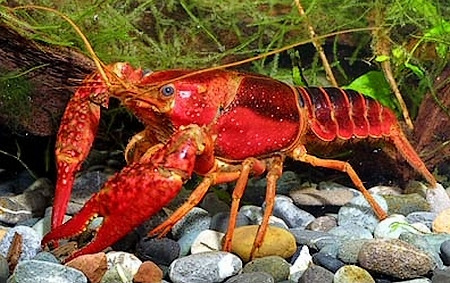
(Image: a red swamp crayfish (Procambarus clarkii), seen from the side. It is a long, lobster-like crustacean with a rigid front half and flexible tail ending in a wide fan. It walks on 8 legs and has a large pair of pincers held in front of the body. The head ends in a pointy snout with two eyes on short stalks and two pairs of antennae. This one is mostly red, with darker portions on the back. End ID)
The crayfish I'm covering today are freshwater members of the clade Astacidea. This clade also contains clawed lobsters, so there is a lot of similarity between the two groups. There are four families of crayfish, split between two superfamilies. These families are largely split up by region. The superfamily Astacoidea are known as northern hemisphere crayfish and contains the families Cambaroididae (found in eastern Asia), Astacidae (found in west Asia, Europe, and Western North America), and Cambaridae (found in eastern North America). The superfamily Parastacoidea, or southern hemisphere crayfish, contains the family Parastacidae, members of which live (or used to live) in South America, Madagascar, and Australia and New Zealand.
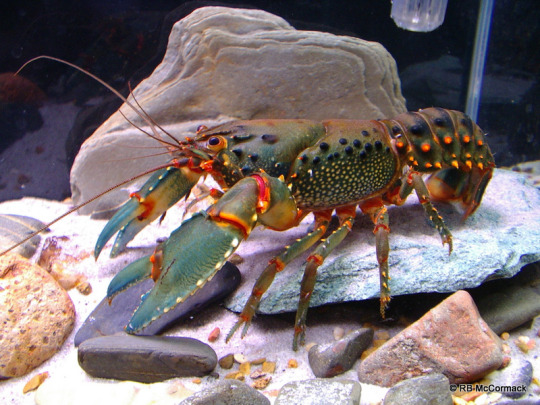
(Image: The Sydney spiny crayfish (Euastacus spinifer) seen from the side. It is a dark green in color, with orange outlines and orange and black spines around the body. End ID)
Crayfish are very similar to clawed lobsters in appearance and have a fairly typical decapod body plan. Their bodies consist of 20 segments grouped into two main body parts: the cephalothorax and abdomen. The cephalothorax is rigid, covered by the carapace, and contains the head and attachments for the legs. The head includes two stalked eyes, two sets of antennae, and a sideways opening mouth surrounded by leg-like maxillipeds that help manipulate food. As a decapod, crayfish have 10 legs. Like their clawed lobster cousins, crayfish use four pairs for walking while the front pair have been modified into a pair of large pincers used for defense and capturing food. Lost limbs can be regrown, though it takes a while. The abdomen forms the flexible "tail". Each segment of the abdomen contains a pair of appendages called pleopods or swimmeretes. These help circulate water and can be used to swim in juveniles. In males, the first pair of pleopods is modified into grasping structures used to hold onto the female during mating. The abdomen ends with a fan-like structure called the telson, that acts like a fin. By rapidly curling its abdomen beneath it, a crayfish can shoot backwards away from danger. The largest species of crayfish, and largest freshwater invertebrate, is Astacopsis gouldi, the giant Tasmanian freshwater crayfish. It can reach 80 cm (31 in) long and 6 kg (13 lbs), though such large individuals are rare. Most crayfish species are considerably smaller.
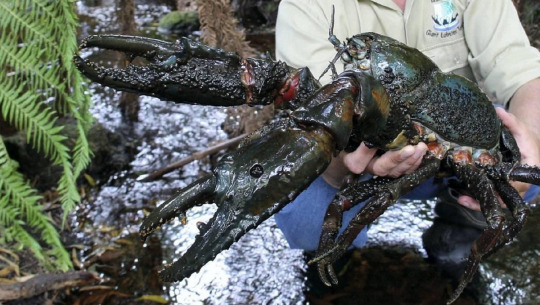
(Image: someone holding a giant Tasmanian crayfish up to the camera. It is extremely large for a crayfish, requiring two hands to hold and its pincers are roughly as long as the person's hands. It is a dark, swampy green to black in color, with many small lumps on the body. End ID)
Crayfish are benthic omnivores and detritovores found in both running and still water. Crayfish are opportunistic feeders with extremely varied diets that include plants, fungi, animals, microorganisms, and decaying organic matter. Mist species are considered primarily herbivorous and scavengers, though they will take live prey if the opportunity arises and have been known to be cannibalistic. Decomposing organic matter forms a large portion of the crayfish diet and they often eat it through the mud and slime found on the bottom of their habitats. A crayfish can quickly swallow mud, then internally sort it by the size of ingested particles. Coarser materials are processed and excreted faster. The digestive tract can process the dead plankton and decaying organic matter that makes up mud from the sediment. Feces are excreted wrapped in a peritrophic membrane. This membrane is rich in proteins and is usually eaten by the crayfish to regain them and get a second shot at digesting organic matter in the feces. Fresh vegetation is also a major food source and there are even reports of crayfish leaving the water to graze on land plants. Crayfish feed periodically, switching between periods of feeding and periods of hiding while they digest. As with all crustaceans, crayfish have to regularly molt their exoskeletons as they grow. They typically eat their old carapaces to regain the calcium carbonate and other molecules contained in the shell. After molting, it takes time for the new exoskeleton to harden, leaving the crayfish more vulnerable to injury or predation.

(Image: a small, orange crayfish in captivity inspecting a cucumber slice that is being offered as food. End ID)
Crayfish mate seasonally, usually in spring through late summer, triggered by changes in water temperature. The exact mating process depends on species, though females are likely to release pheromones to attract males. Males are initially aggressive, but often calm down sometime before mating. Males are known to fight over access to females. In some species, the male and female will touch claws and exchange chemical signatures prior to mating possibly as a courtship ritual. Males have also been seen attempting to mate with other males. Once a female accepts a mate, the male will flip her onto her back and align their abdomens, using his modified first pair of pleopods to grab on. Once their genitals are aligned, the male will pass a sac of sperm to the female using structures called gonopods. The male will leave after mating. The female lays clusters of eggs that are carefully attached to the pleopods. Until the eggs hatch, the mother will carry them with her, moving her pleopods to circulate water around them and using her legs to clean them. Egg development can takes days to weeks depending on species. The young are born well developed for crustaceans, looking like miniature adults. The female will shake her pleopods to help the hatchlings emerge. Juveniles are at a high risk of predation, including from other crayfish, so only a few of the possible hundreds of eggs will reach adulthood. It can take years for a crayfish to reach sexual maturity.
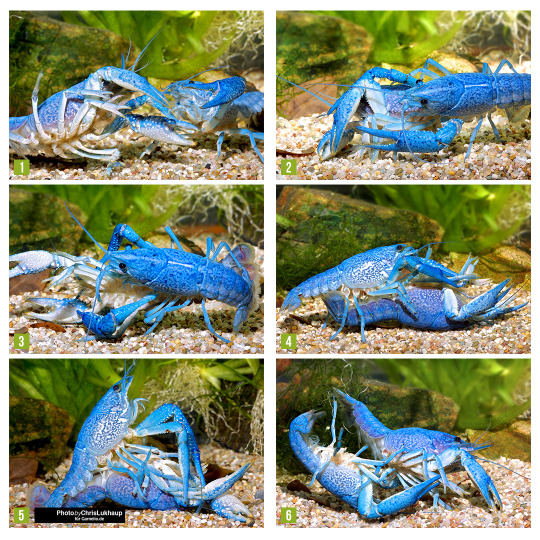
(Image: a series of 6 photos showing two blue crayfish mating. In the first three photos, the male turns the female on her back. In the 4th photo, the male starts to line up his abdomen with hers. In the 5th photo, the abdomens are aligned and mating is occurring. In the last photo, the male climbs off of the female. End ID. Source)

(Image: a female crayfish being held upside down to show her eggs, visible as small, black balls attached to the underside of the abdomen. End ID)
Crayfish are edible and eaten worldwide, with 95% of the world supply coming from China. Boiling is the most common form of cooking. Experiments have shown that crayfish take a while to die when boiled and show pain responses. They also release cortisol, a stress hormone, when boiled. There is, for some reason, a debate on whether or not crustaceans can feel pain. I think that it's obvious they have negative responses to negative stimuli and therefore it can be safely assumed that they can suffer. To more humanely cook a crayfish, freeze them for a few hours to render them unconscious, then cut down the body lengthwise to destroy the nervous system before boiling. Crayfish are also kept in aquariums as pets and can be fed shrimp pellets and plants, but they may also try to eat other organisms in the same tanks. In the wild, many species of crayfish are threatened by overfishing, habitat loss, climate change, and pollution. Most species need clean water and are highly vulnerable to pollutants. This allows crayfish to be used as an indicator species for the health of their environments. The pseudofungus Aphanomyces astaci causes a fatal disease called crayfish plague that has escaped from aquacultures to affect wild populations. Side note, I had no idea pseudofungi were a thing until right now. Multiple species of crayfish have become invasive species after accidental or intentional release of common food species. Other invasive species can outcompete or prey on native species.
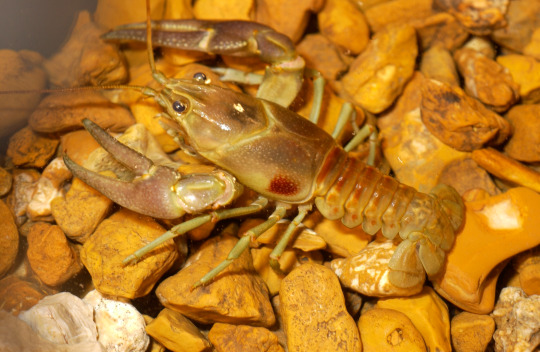
(Image: the rusty crayfish (Faxonius rusticus), a common invasive species in North America, identifiable by the rust-red blotch located on the sides of the carapace near the rear of the cephalothorax. End ID)
#wet beast wednesday#crayfish#crawfish#crawdad#yabby#yabbies#kōura#mudbug#graphic crayfish sex#crustacean#invertebrates#invertiblr#freshwater#claws#ecology#biology#zoology#animal facts#informative#educational#image described
102 notes
·
View notes
Text
Rolan Valentine's Day One Shot - Sex Pollen
Inspired by this vday challenge from @fic--writer finally finished one of my older WIP pieces. It's a different format than what I normally do, so lmk what you think about the outline style. Cute and fun, but also wildly smutty.
NSFW, piv, unprotected sex, oral, marathoning, unintentional psychadelic usage, anal
pairing: f!reader x Rolan, f!Tav x Rolan
word count: 2000

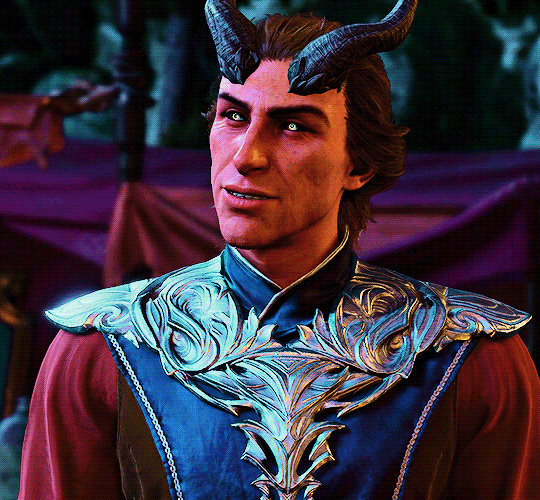

You and Rolan had travelled to the Underdark for a week to attend a conference hosted by the Society of Brilliance. It was a celebration including guest lecturers, demonstrations, and vendors who were all there to highlight the flaura and fauna of the Underdark as well as their uses, and any recent discoveries. Blurg had sent over an invitation to the Tower inviting the pair of you to partake, which you both enthusiastically accepted.
Rolan was absolutely thrilled and babbled excitedly while you packed your bags and prepared for the journey to the convention. After saying goodbye to Cal and Lia, you both took the pass through Bonecloak’s basement and ventured into the Underdark.
When you arrive at the festival, you check in with Blurg who excitedly shows you both the schedule before leading you to your tent for the week. After unpacking, you lay on the bed rolls with Rolan as you both pick out the things you must see and do as he rubs you back and you both relax for the evening, excited for the week ahead.
The first three days go according to plan; Rolan picks out several lectures on new species that have been discovered as well as some demonstrations on new uses for Sussur blossoms. You find an interesting talk on physical areas that need more exploration hosted by Omeluum. It’s an exciting week, and you love seeing Rolan geek out as he asks many thoughtful questions at every lecture you attend.
As you both get ready for bed that evening, Rolan mentions learning about the Myconids from a lecturer. You can’t help but animatedly recount your own encounter with them as Rolan hangs on your every word. He is so fascinated, and you begin to scheme up a small side adventure for the next day as you drift off to sleep.
You both signed up for a tour group that travels through the Underdark for several hours as a guide points out various species while you wander about. After an hour or so, you recognize the terrain as being somewhat close to the Myconid colony and you stop Rolan as you pretend to relace your boots and the group moves almost out of sight.
“Tav we’re going to lose them!”
“Well, the good news is that I happen to have some friends nearby…some friends I think you’d like to meet.”
Rolan’s eyes grow wide and he quickly catches on and excitedly helps you back to your feet as you give him a sly grin and start heading in a different direction, Rolan’s hand firmly around yours as you lead the two of you deeper into the Underdark
You walk for a short time before something catches your attention; a glowing, pink, sphere-shaped fungus that practically buzzes when you look at it. Rolan quickly follows your line of sight, “Do you recognize that species? I haven’t seen anything like that catalogued in any of my reference books!”
Shaking your head, you notice a trail of these plants leading into a crevice in the rock. You glance at Rolan playfully before squeezing yourself through and you find a small pool of aqua blue water surrounded by the little pink fungi, its glow illuminating the small cave in a rosy glow. That’s when you notice several bedrolls around the water, as well as a large bottle of what smells to be…rose oil? You start to speak, but Rolan cuts you off, excitedly shouting from across the small cavern, “Look at this one!”
You turn around and crouch next to him on the ground and see a particularly large mushroom with reddish spores on the surface. Ever the scientist, Rolan pulls out an empty test tube from his bag and reaches to scrape some of the substance into his sample jar. He delicately scrapes the top with a blade and gently brushes the spores into his sample jar. He no sooner puts the cork on his sample and the mushroom begins to pulse- no, hum?
You share a confused look, and as you turn back to the fungus it bursts into a thick cloud of magenta pollen and you both cough and try to wave it out of your faces
Rolan shouts through the thick, pink cloud, "TAVVV!" When the dust finally settles, he looks at you to make sure you’re alright, but his face twitches with an odd expression as he scans your body for injuries. Before you can question it, you feel a ripple of heat rush over your body, your mouth goes dry, and you feel a sudden and intense need in your core.
Before you know what’s happening, both of you are furiously tearing your clothes off and Rolan practically pounces on top of you, knocking you back onto the pile of blankets as he starts planting wet, harsh kisses on your neck and his hands start to play with your ass while he desperately begins to hump your thigh
Your hands trail all over his chest and shoulders and you moan loudly as your eyes roll back with pleasure. You glance to the side and see the large bottle of oil, and the excited squeal you make forces Rolan to come up for air as he follows your gaze. He growls enthusiastically as he grabs the bottle and pops the cork off in one motion as he begins drizzling the oil over your nude form before letting it drip down his ridged chest.
You stare at him intently and start touching yourself, rubbing the oil into your skin, begging him to come back to you and the sight practically makes Rolan explode. He pumps his cock and you swear it’s even larger than normal as you watch the oil and precum coat his hard length as he stares at you hungrily
You don’t even realize that you’ve started crying, the few seconds without his touch feels like an eternity and you start begging him to fuck you even louder
Rolan firmly grabs your hips and pulls you onto his lap as he lays back against the blankets, he gently lifts you directly over his hard member and drags your soaked entrance over his tip, causing you to slam down onto him in desperation. He screams your name and you start energetically bouncing on his length, and he slams his hips up to meet you as the sound of your moans echo loudly in the small cavern.
“My Tav, my sweet, beautiful Tav. I want to fill you so full that you can’t stand up, I want to make love to you until I collapse.” Rolan growls out praises at you as his hands play with your breasts and tummy as they bounce with each hard thrust. You feel yourself starting to come, but you can’t stop yourself from bouncing even as you feel your toes curl and you grip around Rolan’s cock so tightly it causes him to fill you with hot seed that starts dripping out of you as he continues thrusting into you at an intense pace
You both shake from your orgasms, but miraculously neither of you are phased as you continue making intense love on the bedrolls. You continue for hours without tiring.
You both get creative with your positions as you continue to please each other. Rolan flips you around in his lap before leaning back and dragging your hips back with him as he pulls your core onto his face and you can’t stop yourself from grinding against his tongue as you lean over to take his ridged length as far down your throat as you can
Rolan even uses a variation of mage hand he’s been practicing to hold down your arms and legs and you scream his name as he eats you out passionately, smiling up at you from between your legs
You grab the oil and wave your ass in the air as you beg Rolan to take you in every way. While normally he’s hesitant for fear of hurting you, his inhibition is gone as he gently presses into your tight ass and he can’t stop swearing as he gently rocks his hips back and forth as you cry loudly at the overwhelming stimulation
It’s like a dream, the way the time passes like nothing as you both explore fantasies you didn’t know you had. Neither of you remember stopping, which is why it’s such a surprise when you awake in an unfamiliar tent.
You hold your head as it pounds, and you notice Rolan stirring awake and he is similarly dazed. It is only when you notice the melodic hum of the myconids that you begin to piece together what must have happened.
As the memories of your wild lovemaking come flashing back into your mind, you can’t help but blush as you glance over at Rolan, whose spellbound grin tells you he also remembers your long side quest.
You quickly put on your clothes that are carefully laid out next to you and the two of you shyly pop your heads out of the tent flap. You smile awkwardly as you make your way to Sovereign Spaw, your lover following close behind you, staring wide-eyed at the colorful creatures that surround you. You kneel in front of your old friend, and Rolan follows suit, but he is unable to hide the wonder on his face
“Life-chanter, you need not kneel to me. You are welcome here, as is your mate. We are thankful we recovered you when we did.”
You both blush intensely as you rise to look at your old friend. “What was that stuff?”
“We have no name for it in your language, but it has proven to induce breeding in creatures of many different species. Its purpose we do not yet fully understand. Not all of your kind have the stamina to survive such a prolonged encounter. ”
Rolan chokes on his spit and he tries to cover it with a cough. Thankfully, the Sovereign either doesn’t notice or is kind enough to ignore the outburst. After he recovers, his curiosity gets the better of him and Rolan asks softly, “May I ask you some questions Sovereign Spaw? About your customs?”
Spaw hums his approval and begins a long conversation with your wizard; you are amazed at the thoughtfulness and care he has put into his questions and hours go by like minutes because of their genuine connection with each other
When you finally depart, Spaw and his entourage walk you to the steps leading back towards your conference. “Life-chanter, I am glad to have crossed paths again.” He turns to Rolan and continues, “Master of the tower, keeper of knowledge; your respect for our customs is unmatched in our many centuries of existence. We shall call you Light of Truth, and you shall always be welcome here.”
Rolan gushes in excitement as soon as you are out of earshot and repeatedly thanks you for bringing him to meet the myconids
It isn’t until you’re both back in your tent and getting ready for bed that Rolan quiets down…too quiet. You sit up on your bedroll and see him hunched in the corner, “Rolan?”
He glances over his shoulder with a devious grin before gently biting his bottom lip, “Tav…how much do you remember from our journey to the myconid colony?”
You blush uncontrollably as Rolan quickly closes the distance between you on all fours, climbing on top of you so that your bodies are just inches apart. From his pocket he pulls his glass vial, shaking the burgundy spores suggestively in front of your face with a smirk.
“ROLAN!” You gasp with shocking realization; you had almost forgotten how your romantic escapade had started.
“Tav darling, it’s for scientific research! You wouldn’t want to stand in the way of important discovery, would you?” He whispers the last part into your ear before trailing kisses and soft bites down the side of your neck. You can’t stop the purr in your throat at his touch and he chuckles into your skin, “I think though, for the time being, I’ve got quite a bit of inspiration for my own tests before I need use our sample again.”

#ValentinesDayAndScreamingRolan#bg3 fanfiction#holy rolan empire#bg3 rolan#rolan brainrot#tiefling#rolan smut#rolan x tav#rolan nation#sovereign spaw#myconid#sex pollen#dividers by saradika
105 notes
·
View notes
Text
"Can you eat a pine tree" - Hearthian Food Exploration part 1
I'm in the middle of a deep dive investigating Hearthian food. Take the words of this post with a pinch of salt. Heh. Omg it's happening, I think this is my first expanded headcanon. I'm so excited. Theory crafting Heathians and their culture around food, sourcing ingredients and preparation techniques.
Disclaimer
So far, the presence of ghost matter wiping out non-aquatic lifeforms seems to limit the availability of hearthian diet to aquatic based life. That being said, it was long enough for Hearthian's to evolve, so let's just ignore inventing entire species for culture is outside a game dev's scope alright. I'm firing off ideas since I want to draw more food and it's raising a lot of curiosity. But that being said, having access to more creaturas opens a lot of doors. I must design one. Fish meat They eat fish. There's enough bodies of water on Timber Hearth to suggest the presence of a variety of freshwater lake and river fishy. We also have the entirety of Giant's Deep which is just an entire planet of sea. The large gravitational pull on that planet amplifies deep sea pressure. I'd like to think that anything coming out of that water would be evolved in such a way to adapt to these critical conditions. Lots of teeth, bioluminescence, blobby or flat bodies. Extra creepy looking. They're all evolved to be ambush predators to preserve energy. They grow really big. Catching one of these titans could feed the village for a week. Incidentally, I drew angler fish hotpot the other day. I imagine the Hearthian population is quite large. At some point you get a group of people risky enough to challenge the anglerfish. I think it'd be like a fairytale or generations of fish hunters who bring back this glory meat. But they can't do it in a flashy loud way, so they develop all this stealthy hunting gear designed to get them really close for the assassinate. HYAAH then they drag this big ass carcass back home through cold space that keeps it fresh.
Food preservation So at it's core food preservation is about dealing with the microorganisms in food, food preservation is finding ways to deal with them so they can't render our feed inedible. So with something like fish (meat, fruit etc.), you're looking to pull the moisture out, you'll see drying racks where they salt the stuff or leave it to hang in the open, you can bake stuff, or put it through a dehydrator. That's far too high tech. Similar techniques with salt (curing) or smoking foods, it's the same principal. Ingredients So we then have to ask, do they have access to edible salt? Primarily that's sodium chloride to us. For the sake of simplicity, Hearthians are surrounded by rocks, and they have good stomachs, so yeah, probably. Having access to salt opens up so many possibilities.
In a similar vein, a really common important ingredient for food is also sugar. The existence of Marshmallows suggests there's natural source. Just wandering around, I think most suitably would be honey, it wouldn't be too far removed to imagine bees on Timber Hearth. There'd be an abundance of flowers, actually I've talked myself into it just now. Bee keeping Hearthians is now in my head. We also know with fish you can boil bones for stocks and gelatine (the latter is also used in marshmallows, sweets and other desserts, not to mention the flexibility it affords us in cooking). And by extension I think natural flora that have fruit. With that and sugar you can make vinegar, which opens up pickling as another food preservation method - pickle fruit, veg, fish whatever. I've been imagining lots of wilds mushrooms and leafy things. The hardiness of Hearthians means they'd probably be more adventurous, even at risk of an upset tummy. There's just an abundance of potential here and I'm no mycology expert, but I do think when I come around to drawing more, focusing on incorporating more fungi is key to interesting dishes. It's so versatile, I think you could think of it like a tofu. Plus the colours and variety of shapes make for really interesting shapes to draw. What about vegetables? There's a lot of potential for naturally occurring vegetables. Which in turn leads to entire bodies of agriculture and options as a staple food. Root veg and leafy greens should be common in the wild. Though rice and grains to grow maybe? Pine trees So this is where I started this entire rabbit hole. I thought, well, they can't just survive off fish and marshmallows. Haha... Unless? Literally first question "can u eat tree bark" Turns out in some cases... yes. Kind of. The two models in game are more likely pine trees (Pinus sylvestris) and redwood pines (Sequoia sempervirens). Outside the usages of wood as we know it for buildings and spacecraft, as far as I could find, the edible bits are split into: cones needles bark sap nuts You can apparently boil the tight closed green female (???) cones to soften them and eat. But stay away from the barky stuff. It's old and wood like lol. Actually did you know pinecones make for great fire starters. Get a couple dry ones when you're camping and chuck them in. Needles, it's possible to make tea out them, random reddit comments say it tastes like juniper berries (like in gin). It's quite healthy too. Allegedly they have medicinal purposes else they're used for mulch (for fertilising plants). I always imagine Heathians to be careful for future generations like that. I found some posts talking about using the pine needles as a flavouring for smoking your fish, so potential here too. Bark. I really wanted some evidence of people just chewing on hunks of wood. You know like how a toddler monches on toy blocks. Turns out inner pine bark was used in something called bark bread. It was a starvation feed where they used the stuff to pad out the flour to make it go further. It didn't have much nutritional value so as soon as possible it was cut. Sap wine exists. Generally pine sap isn't used for food purposes. Who am I to question it. Actually far from it, I think if we start incorporating extra sugars (from root vegetables, wild flowers and fruits), the process of fermentation actually opens up so much. Alcohol, vinegar, heck if we start factoring in the potential for additional creatura, then we can have milk, therefore cheese, yogurts and stuff. You start combining all of that with plants and medicinal whatnot, we have the potential for cosmetics and medical products. Imagine that, hearthian makeup. So pine nuts are a classic. You can roast them, throw them on a salad, with fish and meats, turn them into a dessert. They're super versatile. For a treat you could turn it into flour. Super expensive, but maybe for big occasions - like a festival? I'm at the character limit. I'll be back.
32 notes
·
View notes
Text
In High School, I made it all the way to Regional Science Fair (a Big Deal for a science kid) with a project where I took soil samples from our back yard and grew the bacteria/fungi from shaken distilled water suspensions of them on agar in petri dishes over the course of the year.
After they'd grown large enough and there seemed to be no new growth, I looked at them and started isolating the ones that killed all the surrounding colonies of other bacteria off.
The ones that grew with a distinct EMPTY ring around the whole colony were the ones I isolated and grew in their own sub-cultures, and they belonged to a group called "actinomycetes", the whole point being that we ought to look at backyard dirt for sources of new antibiotics.
I was a Junior, this was in 1975-76.
31 notes
·
View notes
Text
Hello! Sorry for the inactivity, posting the same drawings on 5 different platforms with different limitations is quite exhausting, so I'll be posting my Spectember drawings in batches until I finish it :>
So without further ado, here's the second week of Spectember:
Day 8: Ambush Predator
Featuring the Titan Låtmimik (Venatoramus longus), a giant carnivorous katydid from the northern forests of Antarctica, which can imitate the calls of certain bird species to attract them closer to their lethal grasp
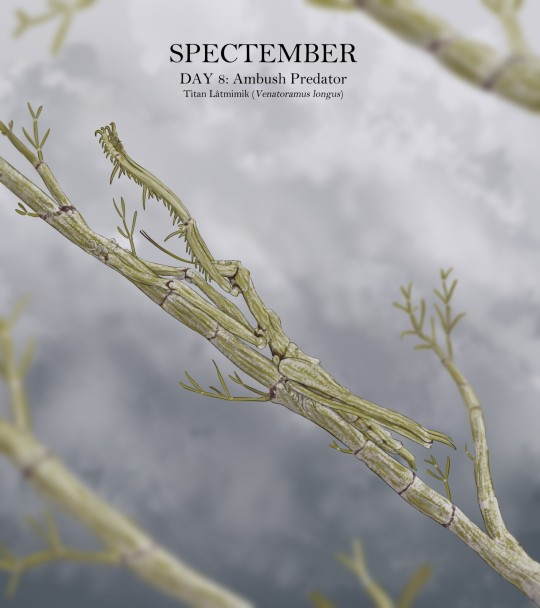
Day 9: Producer
Featuring the Ggulu Orchid (Caelorchis divinitus), an orchid common in the Muraanad forests of the Somalian subcontinent, where it grows from the fungi growing chambers of the termite nests, taking advantage of the fungi until it bursts out of the nest, finally able to photosynthesize and flower.

Day 10: Filter Feeder
Featuring the Wandering Dumingo (Pinnatocetus celer), a seafaring member of the dumingos, a family of filter feeding mallard descendants, which embark on incredibly long migrations across oceans, from pole to pole, in the search of summer plankton booms.

Day 11: Semi-aquatic
Featuring the Beringian Selkie (Sennapithecoides polaris), an aquatic rodent from the Arctic region, which spends most of its life diving and digging around the coastal mudflats in search of invertebrates to feed on, including clams and crustaceans.

Day 12: Megafaunal
Featuring the Transoceanic Navalodile (Galleonosuchus imperator), the largest of a group of seagoing crocodiles, which patrols the equatorial waters of the Pacific and Atlantic oceans, constantly searching for fish, rarely encountering others of its kind.

Day 13: Grazer
Featuring the Rugose-browed Pricklyhog (Hoplohippus rugosus), a large porcupine descendant that lives in the African grasslands, protected from predators by its thick skin, and large keratinous plaques and spines that cover it.

And day 14, some fanart of one of the OG spec books, After Man. One of my favourite creatures from its incredible roster, the Night Stalker!

#art#illustration#clip studio paint#speculative evolution#speculative biology#fanart#art challenge#spectember 2024#spectember
65 notes
·
View notes
Note
You know fallout? 👀
Because I wouldn't say no to a deathclaw type monster dominating a little human that stumbled into his territory
I do not but I did a bit of Googling. Sorry this request has taken so long and sorry if I’m not lore accurate! The picture I’m basing most of this off is this one. Hope you enjoy.
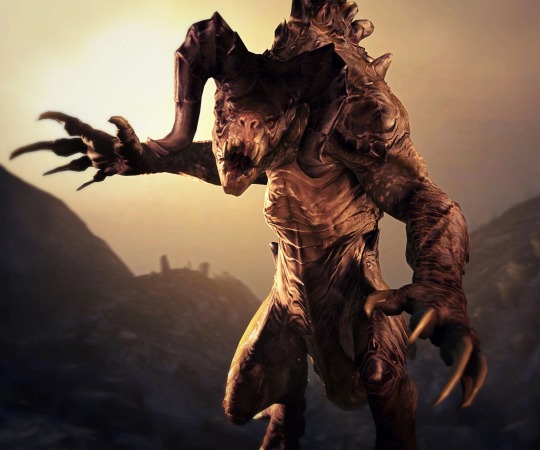
Gen! Reader
It had been years, but finally you were able to leave the bunker you and your family had been hiding in. The radio said that it was safe enough. Sure, they had been saying that for weeks, but you wanted to be safe. Supplies and rations were running low, and you wanted to see what you could find.
You didn’t expect to find a herd of mutated monsters tearing into what looked like a giant mushroom, snapping at each other and the enormous fungi. One of the creatures seemed to catch your scent as you stood shocked, frozen in place. It turned towards you, eyeing you curiously before lumbering away from the group. The rest of them don’t seem to notice as it wandered over to you.
Your throat felt tight as you started to back up, then bolted. It was an attempt made in vain, of course, because the creature didn’t even have to break a sweat before it caught you.
“My… territory,” it muttered as it wrapped a clawed hand around you, lifting you to look at you closer up.
“What?” you squeaked out, confused and surprised. While you had heard of some mutated creatures, Deathclaws?, being able to mimic human speech, you hadn’t expected to really experience anything.
“My territory… not for humans,” it grunted, looking at you with a look of what you can only describe as contempt tinged with curiosity.
You winced as one of those long claws break the fabric of your shirt, dragging down and ripping it nearly off of you. Your chest was barely covered, though the creature did seem to find that interesting. It continued to drag the thumb claw down your body, cutting away your pants, then your underwear.
You protested, wiggling in its large hand, hitting and biting at the scaley creature’s hand to try to get away. Or just move it’s attention. Anything to get it to stop. However, it only seemed to find that amusing. It set you on the ground, face down and tugging your bare hips up as it mounted you, holding your small frame down with its large hands.
“No, no wait please,” you cried, trying to pull yourself out from under it.
To your surprise, it did stop. Even though now you could feel a large cock grinding against your exposed ass, the beast didn’t make another move to push into you. You took a shaky breath, blinking away tears at the corner of your eyes. What you really didn’t expect though, was it to lift one of its claws off of you, biting it down to a nub.
You were confused until it was pushed into your mouth, making you gag on it, wetting it with your spit. After you had gagged and choked on it, it pulled back just enough to slowly begin to push it into your ass, giving you time to slowly stretch around it. You cried out, feeling your hole stretch around this things finger. Your brain felt foggy, and that was before it suddenly sank into you.
You whimpered and moans started falling from your lips. It was merciless, cracking its fat cock inside of you, bottoming out with every thrust. It wrapped its long claws around your arms, keeping you pinned to the ground as it fucked you into the dirt. With each thrust, you were moaning more and more, your pleasure echoing in the wasteland. The others from the herd had gathered to watch, some of them even palming their own cocks as they watched their leader show you why humans don’t wander into their territory lightly.
After you were good and stretched, the creature now easily sliding in and out of your ass, it pinned you even more to the ground with its body as it unloaded a huge load inside of you.
#writers on tumblr#writing#fantasy romance#author#monster lover#monster romance#monster fucker#monster fuqqer#fantasy smut#smut#monsterfucking nsft#monsterfucking cw#tw monsterfucking#monster fudger#monster kink#monster k!nk#fallout#anon asks#answered asks#asks open#send asks#send me asks#anon ask#nsft ask#fantasy nsft#nsft asks#monster nsft#monster smut
238 notes
·
View notes
Text
Round 2 - Arthropoda - Insecta
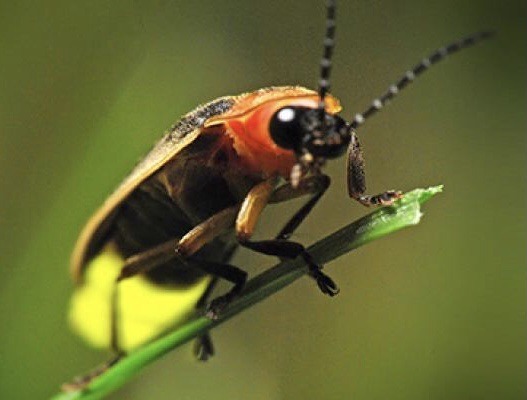


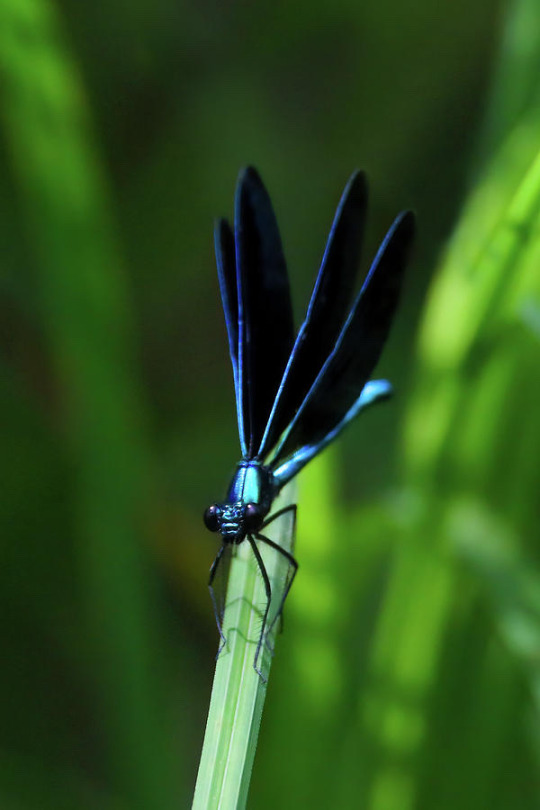
(Sources - 1, 2, 3, 4)
Our last athropods, the hexapod crustacean class Insecta, is one of the most successful groups of animal on earth. They are the most diverse, with over a million known species, comprising more than half of all eukaryote (animals, plants, fungi, etc) species, making them the “Default Animal.” They are comprised of three main groups: Archaeognatha (“Jumping Bristletails”), Zygentoma (“Silverfish” and “Firebrats”), and Pterygota (winged or secondarily wingless insects).
As hexapods, insects have a three-part body plan: head, thorax with 6 legs, and abdomen. They have compound eyes (some in addition to ocelli) and a pair of antennae. Many groups have 1-2 pairs of wings as adults. Insects have many means of perceiving the world: compound eyes and ocelli for seeing, tympanal organs for hearing, and receptors on the antennae and mouthparts for smelling. They live in almost every environment and occupy almost every niche. Many are aquatic, or have aquatic larvae. They are the first animals to have evolved flight. Some are solitary, some are social, some live in large, well-organized colonies. Some communicate with pheromones, some with sounds, some with bioluminescence. Some are venomous, some are poisonous. Most insects hatch from eggs, though some are birthed live. Some hatch as miniature adults, some go through a partial metamorphosis in which the larval stage looks vastly different from the adults, and some go through a complete metamorphosis in which a nearly immobile pupa is formed. Some insects provide maternal care. Some are carnivores, some herbivores, some omnivores, some parasites. Some spend most of their lives in their larval stage, and don’t even feed as adults. Due to the high diversity of insects, it would be impossible for me to summarize them further!
Fossil insects are known from the Paleozoic Era, during which they achieved large sizes, such as the giant dragonfly-like Meganeuropsis permiana, with an estimated wingspan of up to 710 millimetres (28 in), and a body length from head to tail of almost 430 millimetres (17 in).

Propaganda under the cut:
Insects are absolutely critical in all ecosystems, forming the base of the food chain, turning and aerating soil, controlling pests, encouraging or controlling the growth of plants, scavenging and recycling biological materials, and creating topsoil. Without insects, our planet would die.
There are many contenders for “largest insect.” The Giant Stick Insect (Phobaeticus serratipes) is the longest insect in the world, with specimens recorded at over 56 cm (22 inches), including their legs. The Giant Weta (Deinacrida heteracantha) is the heaviest, with a record of 2.5 ounces. Queen Alexandra’s Birdwing (Ornithoptera alexandrae) has the largest wingspan, which reaches up to 30 cm (1 foot) wide.
Meanwhile, the smallest known adult insect is a parasitic wasp, Dicopomorpha echmepterygis, commonly called “Fairyflies”. Males are wingless, blind and measure only 0.127 mm long.
Many insects are popular pets, including various species of mantis, cockroach, beetle, moth, and ant! Some are even domesticated, including silk moths and honeybees.
Many insects are eaten by humans, and farming insects for food is considered more sustainable than farming large chordates. These farmed arthropods are referred to as “minilivestock.”
Shellac is a resin secreted by the female Lac Bug (Kerria lacca) on trees in the forests of India and Thailand. It is used as a brush-on colorant, food glaze, natural primer, sanding sealant, tannin-blocker, odour-blocker, stain, and high-gloss varnish. It was once used in electrical applications as an insulator, and was used to make phonograph and gramophone records until it was replaced by vinyl.
One of the biggest ecosystem services insects provide for humans is pollination. Crops where pollinator insects are essential include brazil nuts, cocoa beans, and fruits including kiwi, melons, and pumpkins. Crops where pollinator insects provide 40-90% of pollination include avocados, nuts like cashews and almonds, and fruits like apples, apricots, blueberries, cherries, mangoes, peaches, plums, pears, and raspberries. In crops where pollinators are not essential they still increase production and yield. Important pollinators include bees, flies, wasps, butterflies, and moths.
Many insects are sacred to humans. In Ancient Egypt, scarab beetles were used in art, religious ceremonies, and funerary practices, and were represented by the god Khepri. Bees supposedly grew from the tears of the sun god Ra, spilled across the desert sand. The Kalahari Desert's San People tell of a legendary hero, Mantis, who asked a bee to guide him to find the purpose of life. When the bee became weary from their search, he left the mantis on a floating flower, and planted a seed within him before passing from his exhaustion. The first human was born from this seed. Dragonflies symbolize pure water in Navajo tradition. In an Ancient Greek hymn, Eos, the goddess of the dawn, requests of Zeus to let her lover Tithonus live forever as an immortal. Tithonus became immortal, but not ageless, and eventually became so small, old, and shriveled that he turned into the first cicada. Another hymn sings of the Thriae, a trinity of Aegean bee nymphs. Native Athenians wore golden grasshopper brooches to symbolize that they were of pure, Athenian lineage. In an Ancient Sumerian poem, a fly helps the goddess Inanna when her husband Dumuzid is being chased by galla demons. In Japanese culture, butterflies carry many meanings, from being the souls of humans to symbols of youth to guides into the afterlife. Ancient Romans also believed that butterflies were the souls of the dead. Some of the Nagas of Manipur claim ancestry from a butterfly. Many cultures use the butterfly as a symbol of rebirth. And the list goes on…
#sorry I had to copy paste some propaganda from the Arthropoda poll I’m tired and it’s A Lot#anyway Chordata tomorrow!#round 2#arthropoda#animal polls#insecta
83 notes
·
View notes
Text
Some Ecology Vocabulary

for your next poem/story
Autotroph - Any organism that is able to manufacture its own food; derive energy from inorganic sources (light or inorganic chemical reactions)
Benthic - Organisms that live on the bottom of the ocean
Biome - A community of plants & animals that occupy a distinct region; defined by climate and dominant vegetation: tundra, desert, grassland & forest; can be subdivided, i.e. boreal, temperate, tropical forests
Boreal forest - (also called Taiga) Largest terrestrial biome, characterized by having very cold winters and coniferous forests
Dessication - Mummification
Detritus - Accumulated organic debris from dead organisms
Detrivore - Any organism which obtains most of its nutrients from the detritus in an ecosystem
Disturbance - An event that alters the ecosystem, i.e. the plant community and possibly the physical environment; natural disturbances include fire, landslides, windthrow, insects, disease, etc. Levels of Disturbance:
Tree-level: affects single trees or small groups of trees
Stand-level: affecting large groups (many hectares) of trees (insect epidemic, hurricane, logging, wildfire)
Site-level: affecting the physical environment is a dramatic way that all life is lost and a new soil environment is created (lavaflow, glacier, landslide)
Planet-level: affecting the planet as a whole (big meteor, death star...)
Frugivore - Animal which primarily eats fruit
Groundwater - Water found underground as a result of rainfall, ice and snow melt, submerged rivers, lakes, and springs. This water often carries minerals. These minerals can accumulate in the remains of buried organisms and eventually cause fossilization.
Halophile - Organism which lives in areas of high salt concentration. These organisms must have special adaptations to permit them to survive under these conditions.
Limnology - The study of river system ecology and life
Orographic Lift - Occurs when an air mass moves over a mountain range, air cools, drops precipitation, then as air moves down the lee side it warms and creates a rain shadow
Pelagic - Organisms that swim through the ocean, and may rise to the surface, or sink to the bottom
Rain shadow - The dry region on the leeward side of a mountain range, where rainfall is noticeably less than on the windward side
Riparian - Having to do with the edges of streams or rivers
Saprophyte - Organism which feeds on dead and decaying organisms, allowing the nutrients to be recycled into the ecosystem. Fungi and bacteria are two groups with many important saprophytes.
Silvics - The study of the life history, characteristics and ecology of forest trees
Tolerance - The capacity/ability of an organism to endure (survive, withstand) adverse effects from unfavourable environmental conditions; the opposite of sensitivity
Upwelling - The raising of benthic nutrients to the surface waters. This occurs in regions where the flow of water brings currents of differing temperatures together, and increases productivity of the ecosystem.
Xeric - Describes an environment or habitat with little moisture; dry to very dry
Sources: 1 2 ⚜ More: Word Lists
#ecology#terminology#word list#science#writing reference#dark academia#studyblr#langblr#writeblr#spilled ink#light academia#literature#writers on tumblr#writing prompt#poetry#poets on tumblr#writing inspiration#writing inspo#writing ideas#creative writing#john frederick lewis#writing resources
76 notes
·
View notes